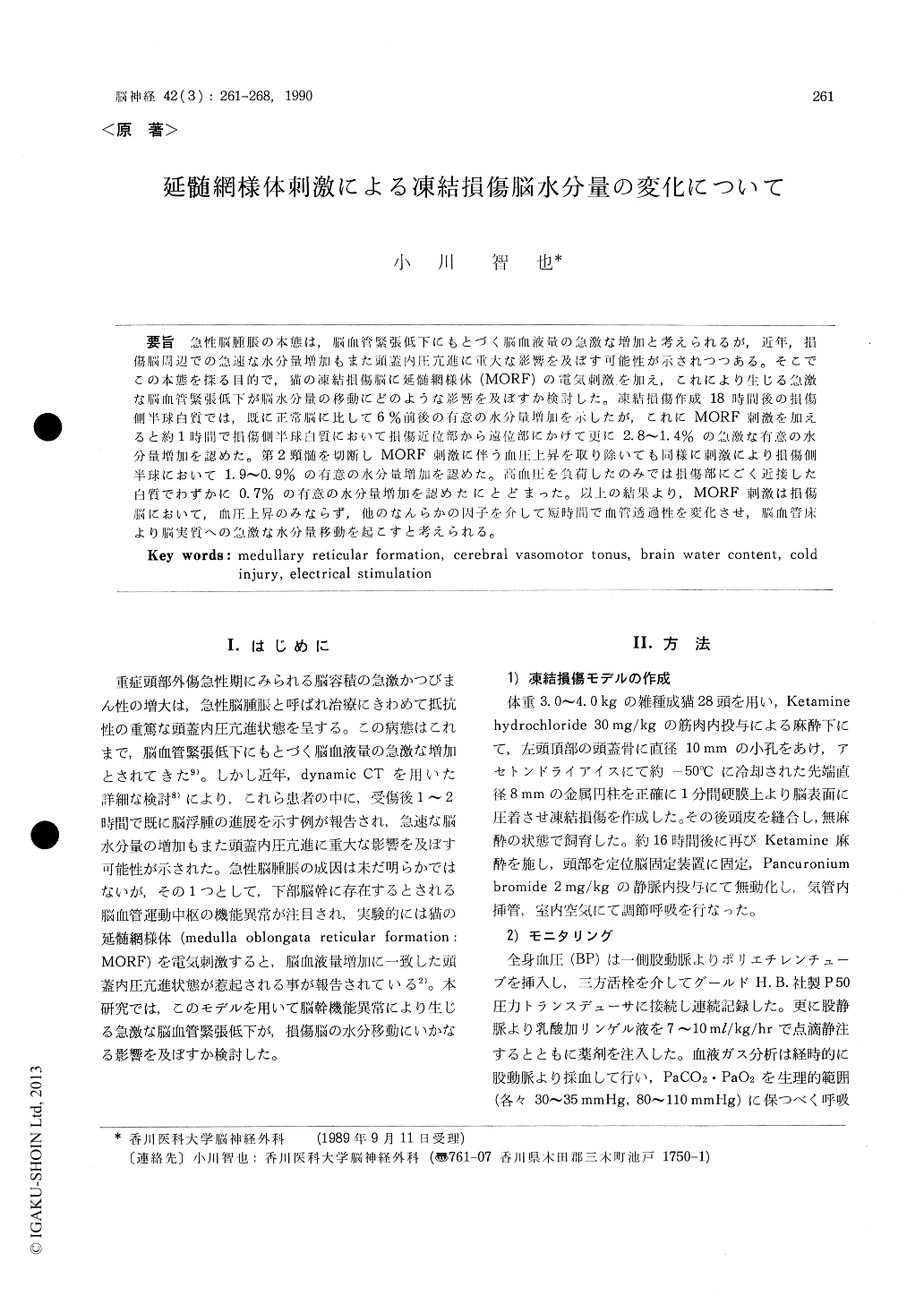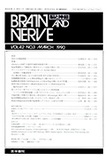Japanese
English
- 有料閲覧
- Abstract 文献概要
- 1ページ目 Look Inside
急性脳脈脹の本態は,脳血管緊張低下にもとづく脳血液量の急激な増加と考えられるが,近年,損傷脳周辺での急速な水分量増加もまた頭蓋内圧亢進に重大な影響を及ぼす可能性が示されつつある。そこでこの本態を探る目的で,猫の凍結損傷脳に延髄網様体(MORF)の電気刺激を加え,これにより生じる急激な脳血管緊張低下が脳水分量の移動にどのような影響を及ぼすか検討した。凍結損傷作成18時間後の損傷側半球白質では,既に正常脳に比して6%前後の有意の水分量増加を示したが,これにMORF刺激を加えると約1時間で損傷側半球白質において損傷近位部から遠位部にかけて更に2.8〜1.4%の急激な有意の水分量増加を認めた。第2頸髄を切断しMORF刺激に伴う血圧上昇を取り除いても同様に刺激により損傷側半球において1.9〜0.9%の有意の水分量増加を認めた。高血圧を負荷したのみでは損傷部にごく近接した白質でわずかに0.7%の有意の水分量増加を認めたにとどまった。以上の結果より,MORF刺激は損傷脳において,血圧上昇のみならず,他のなんらかの因子を介して短時間で血管透過性を変化させ,脳血管床より脳実質への急激な水分亀移動を起こすと考えられる。
Recently it has been reported that stimulation of the medullary reticular formation (MORF) directly decreased the cerebral vasomotor tonus by intrinsic pathways of the central nervous sys-tem and resulted in increases in the cerebral blood volume (CBV) and intracranial pressure (ICP).
Decreased cerebral vasomotor tonus has been postulated to enhance water movement from vascular cavity to the brain tissue. So this study was carried out to investigate the effect of stimu-lation of MORF on brain water content in cold injured brain, which has been confirmed to have a similar pathophysiological nature to cerebral contusion.
Experiments were conducted on 28 cats. The cold injury was inflicted by applying a freezing prove of -50℃ for 1 minute directly on the dura. 17 hours after cold injury, animals were divided into 4 groups, i. e. Group I : cold lesion only, Group II: electrical stimulation of MORF (lmsec, 10 V, 50 Hz) for 10 minutes, which was repeated 4 times with 5 minutes interval, Group III : the same stimulation of MORF for 40 minutes as Group II, with spinal cord transection at C-2 level before the stimulation to eliminate vasopres-sor response, Group IV : administration of An-giotensin II for 60 minutes to elevate blood pres-sure at the same level as observed during the stimulation. In each group, 18 hours after making lesion, the brain was removed and water content was determined by specific gravimetric technique and expressed as percent g water/g tissue. In Group I with cold lesion, the water content of the white matter adjacent to the injured cortex increased to 74. 2% which gradually decreased in tissue samples taken progressively further from the lesion area. In approximately 17 mm distant from the lesion, there were no significant increase in water content. In Group II with stimulation, the water content further increased significantly as compared with Group I by 2. 8 to 1. 4% in the injured hemisphere. In Group III, significant increase of water content by 1. 9 to 0.9% was indicated in the injured hemisphere. In Group IV, only in the white matter adjacent to thelesion showed a significant increase of the water content by 0.7% as compared with Group I.
These results suggest that a rapid increase in water content in the injured hemisphere by stimulation of MORF is not only due to hyper-tension and a decrease in vasomotor tonus result-ing from the stimulation, but also to an increased water permeability across the capillaries surroun-ding the lesion. The increase of vascular permea-bility might be due to the action of substances such as peptides released by stimulation of MORF.

Copyright © 1990, Igaku-Shoin Ltd. All rights reserved.


